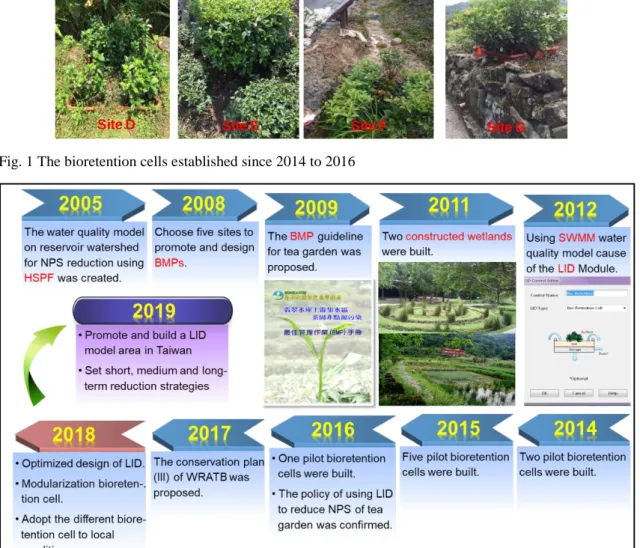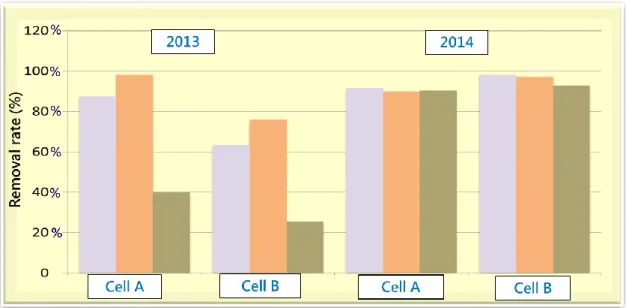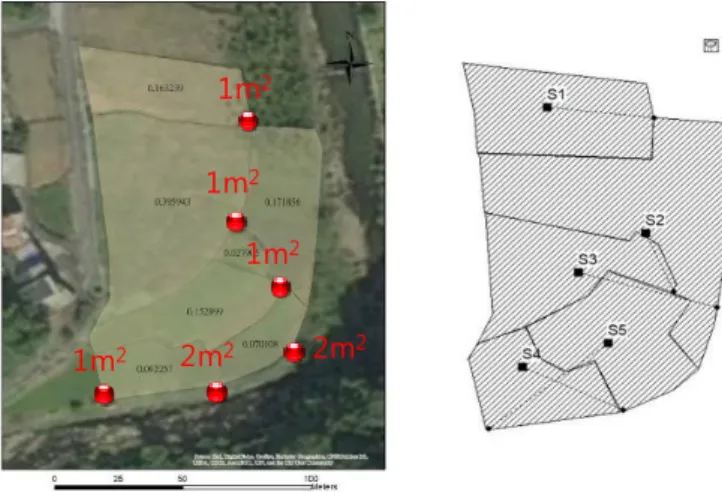The strategies for Non-Point Sources
Pollution Reduction of Tea Garden on Taipei
Water Resources District
Chia-Chun Ho, Chi-Feng Chen, Wen-Shang Chou, Hsiu-Feng Liu,
Chun-Ho Chou, Chung-Chin Lee, Wen-Guei Jang
Abstract
According the Metropolis Plan Act, the Taipei Water Resources District delimits its reserve area for water resources, water quality as well as water volume. The catchment of this District is about 717 square kilometers. Moreover, the Feitsui Reservoir which supplies over five million people’s livelihood water usage is located in this District. To insure the water resources safe and clean is a very importance mission. However, the tea garden area in the catchment is about 650 hectares. The tea garden is the most important source of pollution in this catchment and produces more than 13,000 kg of total phosphorus(TP) per year. In order to reduce the non-point sources (NPS) pollution of tea garden, Low Impact Development (LID) is a commonly used strategy that seeks to mitigate the impacts of increased runoff and stormwater pollution. There are many practices that have been used to adhere to LID, bioretention cell (often called rain garden) is the widely used for treatment of road runoff non-point sources pollution.
EPA's Stormwater Management Model (SWMM) is used for simulations of water runoff quantity and quality in this study. In order to fully promote the LID strategy for removal pollution, it is necessary to established the optimize design process. According to the optimized design results, 10 m2 of bioretention cells are needed to treat the pollution of one-hectare tea garden. Moreover, in order to make the river water meet the water quality standard (TP<20µg/L) rate achieve 85%, the tea plantation per hectare needs to reduce 270g of phosphorus and 326g of phosphorus have to remove if the rate need to achieve 90%. For this result, there are 350 m2 and 2625 m2 of bioretention cell have to build in order to achieve the 85% and 95% of water quality standard achieving rate.
Keywords: Feisui Reservoir, tea garden, Low Impact Development (LID), bioretention cell, Stormwater Management Model (SWMM)
1 Introduction
Stormwater washed off farmland is called agriculture runoff. This runoff is classified as agriculture runoff non-point sources (NPS) pollution because the water often containing suspended solid, organic matter, nutrients, pesticide and other pollutants. Low impact development (LID) is a stormwater management strategy that seeks to mitigate the
impacts of increased runoff and stormwater pollution. Using low impact development approach, stormwater is managed on-site and the rate and volume of predevelopment stormwater reaching receiving waters is unchanged. It can reduce the water runs into storm drainage system and delay its peak flow. Moreover, LID can replenish aquifers and reduce the water pollution through the natural purification systems to achieve the goal of environmental sustainable development.
There are many practices that have been used to adhere to LID, bioretention is the widely used. It is the design flexibility and could be combined with landscape. In addition, they have the effect of improving runoff infiltration and water purification. US EPA’s studies showed those facilities not only can reduce 96% of runoff peak flow but also can remove 35-60% of nutrients in water.
In order to protect the water use in Taipei area, the Taipei Water Resources District delimits its reserve area for water resources, water quality as well as water volume and established The Taipei Water Management Office (TWMO). There are 988 hectares of agricultural land in this district, of which tea gardens account for 650 hectares and produces more than 1,300 kg of total phosphorous(TP) per year (in average). Hence, LID/BMPs are used to reduce the non-point sources pollution from tea garden. It has been more than 10 years since then. This article mainly describes the implementation results and processes over the years.
2 Chronicle of NPS Pollution Treatment
The Taipei Water Resources District is an important water source for about 5 million people in Taipei and an important water source for people’s livelihood. Hence, to keep and predicate the water quality is necessary.
The integral sewage treatment rate in this district has reached more than 75%, but non-point source pollution has not been effectively treated. In view of this, TWMO began to use HSPF (Hydrological Simulation Program FORTRAN) in 2005 to analyze the non-point source pollution in this district and BMPs (Best Management Practices) were planned in 2008 as well as the BMP guideline for tea garden was proposed in 2009. Constructed wetlands were the first BMPs to be adopted and built. Although constructed wetlands can effectively reduce NPS pollution, however, they require a relatively large area and are not easy to maintain. So the BMPs were replaced with a decentralized and small-scale LID from 2012; moreover, SWMM (Storm Water Management Model) was adopted due to its LID modulus. In order to realize the effectiveness of LID on pollution removal, TWMO has set up 8 pilot test sites of bioretention cell since 2014 to 2016 (see Fig. 1). It is known from the pilot test results that bioretention cells have a good effect on pollution removal, hence TWMO will fully promote and set up bioretention cell in this district from 2019. The optimized design process have also been proposed for this district. The chronicle of NPS pollution treatment at TWMO is shown Fig.2.
Fig. 1 The bioretention cells established since 2014 to 2016
Fig. 2 The chronicle of NPS pollution treatment at TWMO
3 The Performance of Bioretention Cell on Pollution Removal
Bioretention is the process in which contaminants and sedimentation are removed from stormwater runoff. Stormwater is collected into the treatment area which consists of a grass buffer strip, sand bed, ponding area, organic layer or mulch layer, planting soil, and plants. Runoff passes first over or through a sand bed, which slows the runoff's velocity, distributes it evenly along the length of the ponding area, which consists of a surface organic layer and/or groundcover and the underlying planting soil. The ponding area is graded, its center depressed.
Site A Site B Site C Site H
Bioretention is one of the distributed LID/BMPs facility not only have the advantages of sample establish, easy operation and maintenance, and low cost but also have the good performance in non-point source pollution removal. Two bioretention cells, A and B, were established in Feitsui reservoir watershed in order to understand the removal ability of tea garden non-point sources pollution in this study. After the installation of those two bioretention cells for 1 to 2 months, the performance of nutrients removed were obvious. For the results from 8 events of storm water sampling and testing from 2013-2014, the average removal rate of suspended solid (SS) is 98.1% and 89.9% for bioretention A and B respectively. The average remove rate of ammonia nitrogen (NH3-N) for bioretention
A is 40%(2013) and 90.3%(2014); for bioretention B is 25.4%(2013) and 92.8%(2014). In addition, the average removal rate of TP is 87.8% in 2013 and 91.5% in 2014 for bioretention A and 63.4% in 2013 and 98.1% in 2014 for bioretention B (see Fig. 3).
Fig. 3 The performance of pollution removal rate
4 The Optimized Design Process of LID
In order for LID to be effectively and reasonably set up, this study has developed the LID optimization design process.
Step 1: Set the water quality goal
Step 2: Calculate the TP reduction to meet the goal
Step 3: Calculate the removal amount of TP for tea garden per hectare Step 4: Calculate the number of LIDs required
Step 5: Field survey to determine the number of LIDs
For the three main streams flowing into Feitsui reservoir, Jingualio, Daiyujue, and Beishi river, the water quality meets the Class A water quality standard (TP20g/L) is required.
Taking the Jingualio river as an example and using SWMM analysis, the achievement rate of water quality in the last three years is 53.3% and the capacity of TP is 534.74kg/yr. We set a short-term water quality goal achievement rate have to more than 85%. That is, the TP capacity can only be 518.22kg/yr and 16.52kg/yr of TP have to remove. If we allocate the reductions evenly to all the tea gardens in this catchment, then the tea garden per hectare must reduce the TP by 270g/ha-yr. Moreover, the 26.38 kg/yr of TP have to remove for the water quality medium-term goal achieve 90% of the achievement rate and 326g/ha of TP must remove per year (see Table 1). If we want to reduce TP to reach the short-term goal of water quality, 350 m2 of bioretention cells will have to establish in Jingualio river catchment. However, 600 m2 of bioretention cells will have to establish in order to achieve the medium-term goal.
Tab. 1 The achievement rate for different water quality goal in Jingualio River
achievement rate for Jingualio River
TP capacity TP removal TP removal per ha
(kg/yr) (kg/yr) (g/ha-yr)
53.3% (Now) 534.74 - - 85% (Short-term goal) 518.22 16.52 270 90% (Medium-term goal) 508.36 26.38 326
One of tea garden was selected to establish the bioretention cell (see Fig. 4). The area of this garden is 1 hectare and the average slope is 6%. To analysis by SWMM, 8 m2 and 10 m2 of bioretention cells have to set up in this tea garden in order to acheve the short-term and medium-term goal respectivitly. After the investigation on-site, there are only can set up 8 m2 of bioretention cells (see Fig. 5). Therefore, this tea garden needs to set up other
LID facilities to achieve the medium-term goal, such as bioswell, grassed waterway, and so on.
Fig. 5 Suitable for setting the location and area of LID
5 Conclusion
The Taipei Water Management Office is very concerned about the problem of non-point sources pollution in the reservoir catchment, so the pollution reduction works and strataegies has been promoting since 2005. Until now, the TWMO has continuously revised and improved the pollution reduction technologies and strategies. LID is a widely used method in recent years. In addition to set up the pilot test fields to confirm the effectiveness of LID on water purifucation, the government has also developed an optimized design process for LID. With the previous experience, TWMO is currently widely promoting and setting up the LID in the catchment. Looking forward to more significant water quality improvement in the future.
Reference
Davis, Allen P. (2007). Field performance of bioretention: Water quality. Environmental Engineering
Science, 24(8), 1048-1064.
Ergas, S. J., Sengupta, S., Siegel, R, Pandit A, Yao Y, Yuan X. (2010). Performance of Nitrogen-Removing Bioretention Systems for Control of Agricultural Runoff. Journal of Environmental
Engineering, 136(10), 1105-1112.
K. Bratieres, T. D. Fletcher, A. Deletic, Y. Zinger (2008). Nutrient and sediment removal by stormwater biofilters: A large-scale design optimisation study. Water Research, 42, 3930-3940.
Lucke, T., Nichols, P. W. B. (2015). The pollution removal and stormwater reduction performance of street-side bioretention basins after ten years in operation. Science of the Total Environment, 536, 784-792.
Li, M.-H., Sung, C., Kim, M., Chu, K.-H. (2011), Assessing performance of bioretention boxes in hot and semiarid regions: Highway application pilot study, Transportation Research Record, 2262, 155-163.
1m2
1m2
1m2
Le Coustumer, S., Fletcher, T.D., Deletic, A., Barraud, S., Poelsma, P. (2012), The influence of design parameters on clogging of stormwater biofilters: A large-scale column study, Water Research, 46 (20), 6743-6752.
Trowsdale, S. A., Simcock, R. (2011), Urban stormwater treatment using bioretention, Journal of
Hydrology, 397, 167-174.
Winston, R. J., Dorsey, J. D., Hunt, W. F. (2016), Quantifying volume reduction and peak flow mitigation for three bioretention cells in clay soils in northeast Ohio, Science of the Total
Environment, 553, 83-95.
Yang, H., Dick, W.A., McCoy, E. L., Phelan, P. L., Grewal, P. S. (2013), Field evaluation of a new biphasic rain garden for stormwater flow management and pollutant removal, Ecological
Engineering, 54, 22– 31.
Authors
Chia-Chun Ho (corresponding Author)
Department of civil and construction engineering, National Taiwan University of Science and Technology (NTUST), Taiwan
Email: cchocv@mail.ntust.edu.com Chi-Feng Chen
Department of Natural Resources, Chinese Culture University, Taiwan Wen-Shang Chou
Hsiu-Feng Liu Chun-Ho Chou Wen-Guei Jang



